Oryza sativa is the scientific term for the rice we eat on an almost daily basis. Interestingly, with a cultivation history of over 5000 years, rice is one of the oldest grains.
The reasons for the rice’s widespread popularity are its availability, preparing simplicity, long shelf-life, and budget-friendly price tag. But, considering that more than half of the world uses rice as a staple food and almost every country has a national dish involving rice, it is reasonable to ask – what about dogs?
Can dogs eat rice? Yes, rice is a dog-friendly carbohydrate source. In fact, not only can dogs eat rice, but it also comes with several health benefits, and dogs enjoy its sweet taste and smooth, soothing texture. However, it must be noted that rice is not a staple food for dogs, meaning it needs to be incorporated in an otherwise complete and nutritionally balanced diet.
This article will make a brief nutritional overview of rice and discuss the health benefits and potential risks of adding rice to your dog’s food bowl. Then, we will go through the different types of rice – review their dog-friendliness and feeding instructions.
PART 1 – NUTRITIONAL ANALYSIS, HEALTH BENEFITS, AND RISKS FOR DOGS
This section will take a closer look into the rice’s ingredients and explain their health benefits and the health risks associated with inadequate use for dogs.
NUTRITIONAL ANALYSIS OF RICE FOR DOGS

Contrary to popular belief, rice is not an empty filler – ingredients that add bulkiness to the food but has no particular nutritional value. The truth is rice contains plenty of ingredients with high nutritional values.
Carbohydrates
Rice contains all three different members of the carbs group – sugar, starch, and dietary fiber. Carbohydrates represent an easily digestible source of energy that fuels the dog’s body. Additionally, carbohydrates are important for ensuring proper food digestion and maintaining blood cholesterol levels.
Proteins
Proteins are simply put building blocks, and when it comes to carnivores a vital ingredient. In addition to being a structural cell component, they are also functional as they enable almost all bodily processes. It should be noted that different types of rice contain different levels of protein.
Vitamins
Some of the vitamins found in rice include thiamine (B1), riboflavin (B2), niacin (B3), pantothenic acid (B5), pyridoxine (B6), folic acid (B9), and vitamin D. rice varieties featuring the husk and bran are richer in these vitamins that polished and refined varieties.
Minerals
Rice contains several vital minerals, including manganese, selenium, magnesium, iron, phosphorus, and copper. Same as vitamins, these minerals are denser in rice varieties with intact husks and brans.
Antioxidants
Rice features many essential and non-essential antioxidants. This nutrient group is highly praised for its ability to fight free radicals, as well as its anti-inflammatory and anti-microbial properties. Colored rice types contain more antioxidants than white varieties.
RICE AND DOGS – HEALTH BENEFITS

The list of health benefits associated with rice is quite long. Namely, when combined with other healthy ingredients, fed in moderation, and occasionally rice has the following health benefits.
Natural body fuel
As mentioned, carbohydrates are the main energy source, and proteins are an additional one. Both nutrients are abundantly present in rice. The vitamins and minerals present in rice aid and enable various metabolic processes that indirectly increase the dog’s energy levels.
Natural diuretic and weight-loss promoter
Rice can help eliminate the retained water from the body, which is excellent for dogs with high blood pressures and dogs on strict weight management regimes.
Plus, the dietary fiber content promotes regular bowel movements, thus additionally helping with weight loss.
Rice is low in fats and cholesterols and, depending on the exact variety, gives a feeling of satiation – it makes the dog well-fed for hours without overwhelming it with heavy nutrients.
The most popular gluten-free grain
To say that rice is a gluten-free ingredient would be an understatement. Rice has specific anti-inflammatory properties and a soothing effect on the dog’s stomach. As a result, rice is the number one grain choice for dogs with gluten sensitivities and allergic reactions.
Healthy digestion and tummy issues management
The mentioned soothing effect is why rice is one of the two basic ingredients (together with chicken) in bland diets for dogs with digestive problems. In addition, the dietary fiber content in rice promotes healthy and adequate bowel movements, thus making rice good for dogs with diarrhea and constipation.
Healthy heart and brain
Rice promotes heart health on several different levels. First of all, it is rich in antioxidants. Secondly, it is low in sodium and cholesterol while high in fiber which is essential for healthy blood vessels. Finally, the mentioned diuretic effect helps with blood pressure management.
The B-complex vitamins found in rice maintain the nerve cells and ensure proper neurotransmission. Plus, the brain runs on energy meaning the rice’s energetic components keep it well-nourished and fueled.
RICE AND DOGS – POTENTIAL HEALTH RISKS

When reviewing the potential health risks associated with rice, they are not specific to dogs but specific for rice and can occur in everyone, including humans.
Rice allergies
Rice allergies are particularly real. Although grain-free diets have gained popularity because of the fad idea that many dogs are sensitive to grains, true grain and rice allergies are rarely seen in practice.
A dog with a rice allergy will probably be allergic to other grains and manifest clinical signs and symptoms like itchy skin, patchy hair loss, and recurrent ear infections.
Heavy metals pollution
Depending on where it is grown, rice may contain certain heavy metals like cadmium, mercury, arsenic, nickel, chromium, and lead. In general, these heavy metals are most likely to pollute rice grown near mining and industrial zones.
Heavy metals accumulate within the body and cause slow and chronic poisoning with potentially lethal consequences.
Anti-nutrients in inadequately produced rice
Rice contains an inositol-based substance named phytic acid. Phytic acid is present in many grains and nuts. It is classified as an anti-nutrient because of its ability to inhibit the absorption of certain important minerals like zinc and iron.
Rice manufacturers undertake many procedures (soaking, fermenting, sprouting) to decrease the amount of phytic rice in their products naturally.
Ergot toxicity
Rice is one of the eight major grains globally, and they are all hosts to a specific type of fungus called ergot. Ergot toxicity triggers clinical signs and symptoms like vomiting, nausea, diarrhea, dizziness, headaches, and seizures.
The fungus growth is visible with the naked eye – the infected rice will have purple or pink spots. However, rice sold for human and dog consumption is rarely infected with ergot because of the strict agricultural practices and grain standards in most countries.
Diabetes and obesity
Logically, high-carb foods are not always suited for dogs with diabetes and obesity issues. However, in the case of rice, the suitability depends on the exact rice type.
While some types have high glycemic indexes and can quickly add pounds on the scale, others have low glycemic indexes and are not associated with weight gains. If your dog has one of these issues, you need to be mindful of the rice type you choose to feed them.
PART 2 – THE DIFFERENT TYPES OF RICE FOR DOGS
There are over 40.000 varieties of rice, and each variety is different in terms of nutritional value, benefits, and risks. Here we will go through some of the most widespread rice types.
CAN DOGS EAT JASMINE RICE?
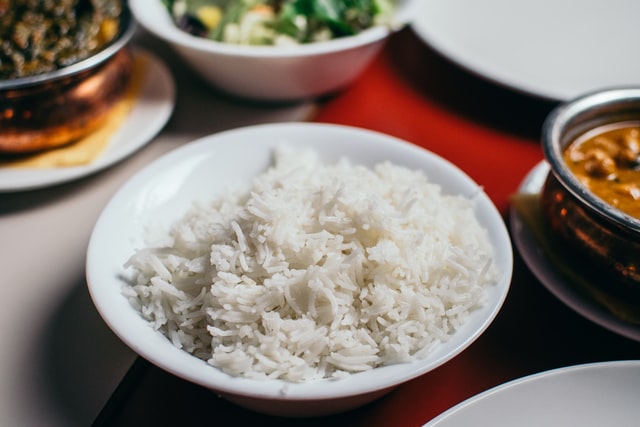
Yes, dogs can eat jasmine rice, which is actually a common ingredient in many dog food formulas. Jasmine rice is a rich carbohydrate source and can be combined with protein sources like meat and veggies.
Jasmine rice is particularly easy to digest and is helpful for dogs with upset tummies and diarrhea. Because of its fiber and starch content, jasmine rice will strengthen the stool and end the diarrhea bout.
However, jasmine rice is not suited for diabetic dogs. Namely, it has a high glycemic index meaning it releases its sugar into the bloodstream very quickly. In diabetic dogs, this can lead to a dangerous blood sugar spike.
If your dog is diabetic, you can offer some other rice types from this list, such as black or brown rice.
CAN DOGS EAT RED RICE?
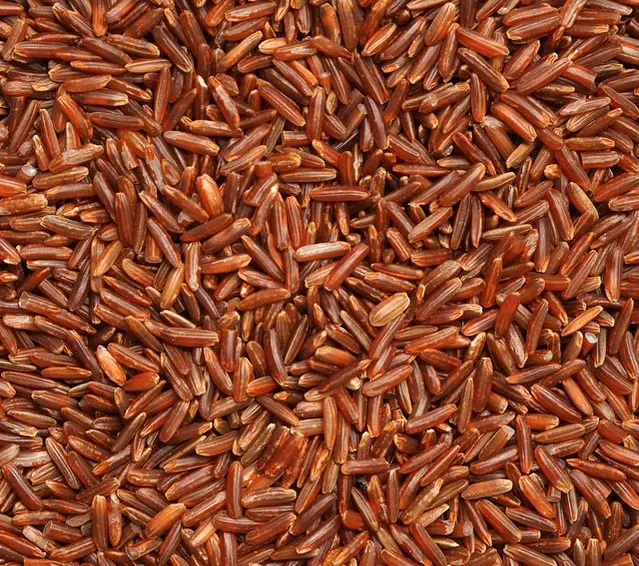
Yes, dogs can safely eat red rice. The general rule of thumb is that rice helps dogs with diarrhea. However, red rice takes the digestive issues management one step further – it can also help dogs with constipation relieve themselves.
Red rice is unusually rich in iron and phosphorus. Additionally, it is loaded with flavonoid antioxidants and health-promoting anthocyanins like myricetin, apigenin, and quercetin.
Generally speaking, flamboyantly colored foods are healthier than their plainly colored alternatives. This applies to rice too. Namely, when it comes to battling free radicals and preventing oxidative damage, red rice is much more potent than white varieties.
CAN DOGS EAT ARBORIO RICE?
Yes, dogs are allowed to eat moderate amounts of Arborio rice – best known as the main ingredient in risotto recipes. It is available in two forms – white (refined) and brown (unpolished).
Arborio rice is extra rich in starches. Although, on the one hand, they give the rice a creamy and soothing texture bit, on the other hand, they also add too many calories. So, in simple terms, although tasty Arborio rice is not the ideal food option for dogs that need to lose weight.
Arborio rice contains significant amounts of protein, vitamin A, and vitamin C. It is rich in dietary fiber (especially the brown variety) and easily digestible. Arborio rice is perfect for restoring bowel function – it helps with both diarrhea and constipation in dogs.
CAN DOGS EAT BASMATI RICE?
Yes, dogs can eat basmati rice because simply put, this is a healthy white rice alternative. That is as long as they do not mind the basmati’s intense flavor and floral aroma.
Basmati rice is low in fat and sodium and has no cholesterol, which is great for dogs with cardiovascular issues. What is more, basmati rice is loaded with essential amino acids and folic acid. In addition, Basmati rice is gluten-free and suited for dogs with gluten sensitivities.
Basmati rice is rich in dietary fiber, iron, and vitamin D. the fiber helps with digestion, iron promotes strong blood, and vitamin D proper calcium and phosphorus metabolisms hence healthy and robust bones.
CAN DOGS EAT BLACK RICE?
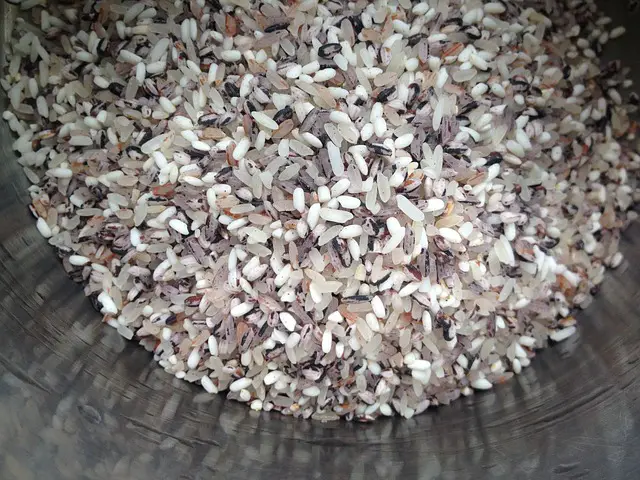
Yes, dogs can occasionally eat small amounts of black rice. In ancient China, black rice was considered a delicacy and allowed only for royal family members.
Black rice is excellent for dogs with tummy issues because it is easily digestible and dogs that need to lose weight because it is low in calories and ensures a longer feeling of satiation. In addition, the anthocyanin pigment responsible for its unique color also has anti-inflammatory properties.
The most important benefit of black rice stems from the fact it contains 23 different types of antioxidants (no other rice offers such a diverse antioxidants palette). Two of those antioxidants – lutein and zeaxanthin are labeled as essential.
Black rice has a characteristic nutty taste which most dogs love, and a rather chewy texture. However, some dogs may find the texture unpleasant.
CAN DOGS EAT BROWN RICE?
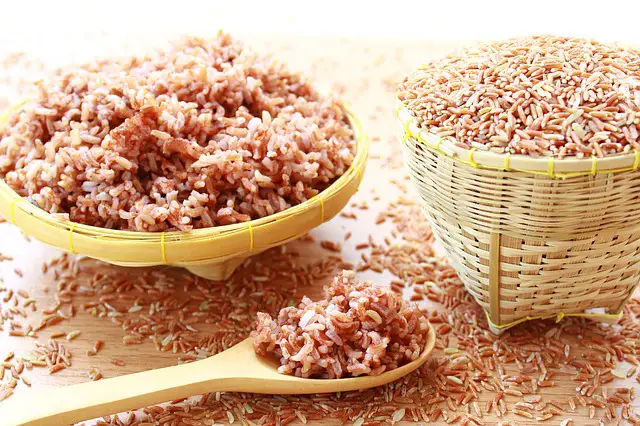
Yes, dogs can safely enjoy the taste and benefits of brown rice as long they do not mind the relatively coarse texture. In addition, compared to regular white rice, brown rice is richer in proteins and fats.
Considering the fact that brown rice has intact husks and brans, it is also particularly richer in antioxidants and healthy dietary fiber. However, the retained husk and bran are not always associated with benefits as the previously mentioned heavy metals are more likely to accumulate in these parts of the plant. Additionally, their presence makes it harder for digestion and not suited for dogs with digestion issues.
Finally, it is worth mentioning that brown rice is an ideal option for dogs with diabetes because of the particularly low glycemic index.
CAN DOGS EAT RED CARGO RICE?
Yes, dogs can eat this red cargo rice. The red cargo rice, also known as Thai red cargo rice, is a long red rice variety with non-glutinous properties. Nutritionally, it is very similar to brown rice and despite its name, the bran color does not have to be red – it can also be purple or maroon.
Red cargo rice is unpolished – the husk is removed, but the bran remains, which means this variety is extra rich in vitamin from the B-complex and dietary fiber. Because it is unpolished, it can be hard to digest for dogs with sensitive tummies. However, it is an excellent choice for dogs with gluten sensitivities, and it is packed with a variety of antioxidants.
The red cargo rice has a sweet and soothing nutty flavor and an earthy aroma. To make it more easily digestible, you can mix it with jasmine rice.
CAN DOGS EAT PARBOILED RICE?
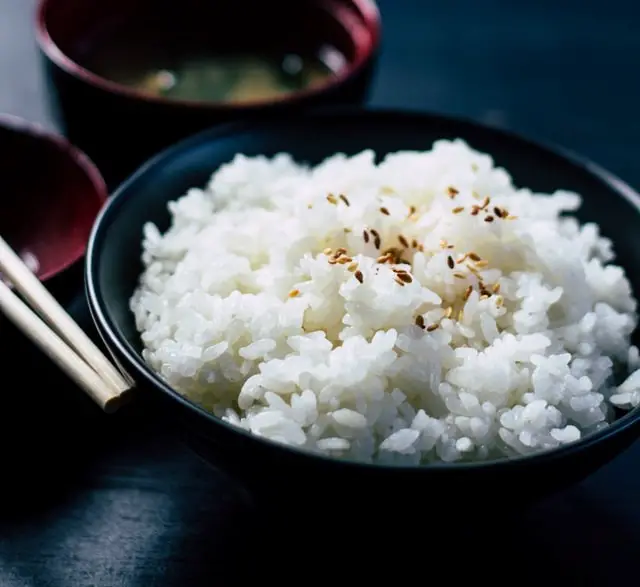
Yes, dogs can eat parboiled rice, also known as converted or easy-cook rice. Parboiled rice is partially boiled while still in the husk by soaking, steaming, and drying. Parboiled rice may look like white rice but in terms of nutrition is resembles brown rice.
The partial boiling helps release the nutrients from the bran into the endosperm, making the parboiled rice a much healthier alternative – it is richer in protein, thiamine (B1), niacin (B3), and dietary fiber.
The steaming part of the preparation turns the starch component into a gel. Consequently, parboiled rice is not associated with blood sugar spikes and an appropriate choice for diabetic dogs.
It is worth mentioning that some dogs might not be fans of the parboiled rice’s strong flavor and chewy, firm texture. Some dog owners are also not fans of the fact that parboiled rice takes longer to cook than white rice (yet not as long as brown rice).
CAN DOGS EAT STICKY RICE?
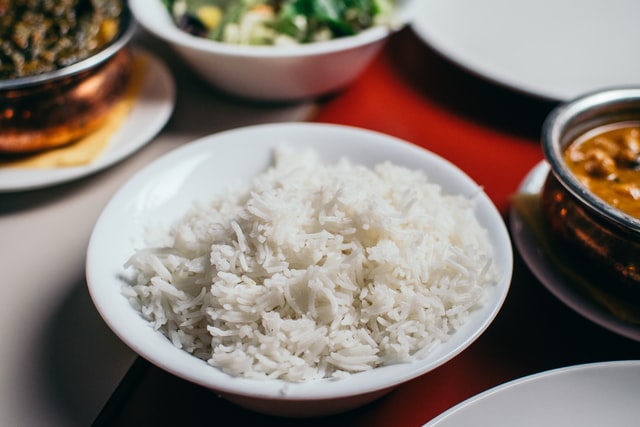
Yes, dogs can eat sticky rice, also popularly known as glutinous rice or sweet rice. Despite what the name suggests, sticky rice does not contain gluten which means it is suitable for dogs suffering from gluten sensitivities.
Sticky rice is an excellent and healthy food choice for dogs with kidney issues. Dogs with kidney issues need low-phosphorus diets, and sticky rice is exactly that. Namely, one serving of brown rice contains around 72 milligrams of phosphorus, while one serving of sticky rice contains only 8 milligrams.
Unlike most rice types, sticky rice contains only one starch type (amylopectin), but it still has a high glycemic index and should not be offered to diabetic dogs.
CAN DOGS EAT SUSHI RICE?
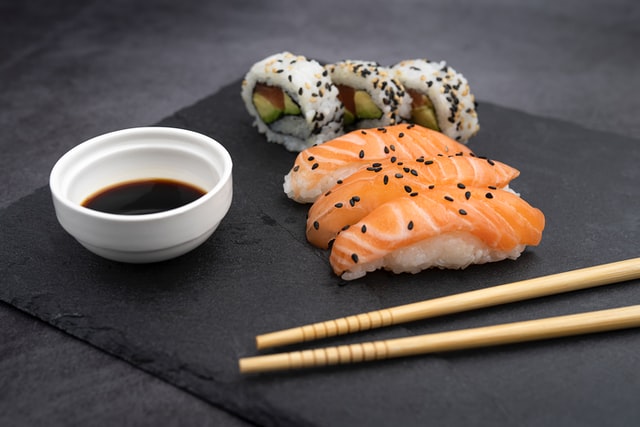
Yes, dogs can eat sushi or short-grain Japanese rice. Sushi rice may look like regular white rice, but it is much shorter and has taste, texture, and consistency.
Rice contains two types of starches – amylopectin and amylose. Sushi rice has a particularly high amount of amylopectin hence the unusually sticky texture. This starch composition makes the sushi rice high in carbs, meaning is not the ideal choice for obese dogs and dogs on weight-loss regimens.
Despite its high carb content, sushi rice is low in calories. Plus, sushi rice is basically fat-free and good for dogs with cardiovascular issues.
Just because dogs can eat sushi rice, does not mean they can eat sushi. In addition to the rice, sushi contains several ingredients that might be troublesome for dogs on multiple levels.
CAN DOGS EAT VALENCIA RICE?

Yes, dogs can safely enjoy the creamy texture of valencia rice, also known as pearl or round rice. The valencia rice has a mild taste and sticky consistency.
The most interesting thing about valencia rice is its ability to absorb a significant amount of water during cooking. While white rice increases its size two times, valencia rice increases three times. This makes this rice variety excellent for dogs that need to lose weight and benefit from the prolonged feeling of satiation.
Plus, valencia rice is a naturally gluten-free food, thus perfect for dogs suffering from gluten sensitivities.
CAN DOGS EAT LONG-GRAIN WHITE RICE?
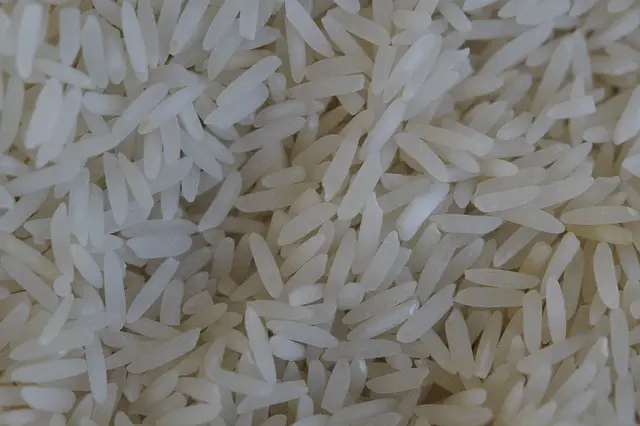
Yes, dogs can eat all types of long-grain white rice. This rice group contains several varieties with long grains – with lengths four to five times their widths.
It should be mentioned that although rich in proteins, vitamins, and minerals, long-grain white rice is not suited for diabetic dogs (because of the high glycemic index).
Finally, if fed in excessive amounts, long-grain white rice can easily lead to gaining unnecessary weight because of the high carbs content. The long-grain white rice has a sweet taste, firm texture, and fluffy consistency.
CAN DOGS EAT WILD RICE?
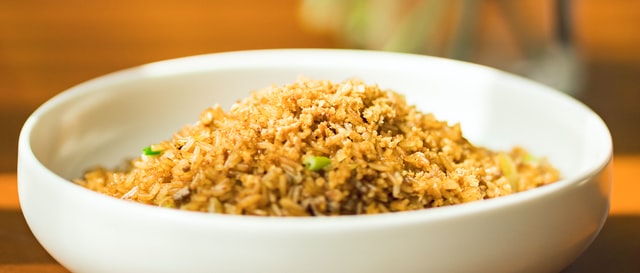
Yes, dogs are allowed to eat this rustic-like grain. Interestingly, despite its name, wild rice is not actual rice – it is the seed of an aquatic grass that grows in shallow freshwaters. It got the rice name because it looks and cooks like rice, but it has a much stronger taste and comes at a much higher price.
Wild rice is an impressive mineral (manganese, magnesium, potassium, zinc, iron, phosphorus, selenium) and plant-based protein source. It also has plenty of antioxidants. Wild rice promotes heart health and lowers the so-called bad cholesterol. It has a low glycemic index and is suitable for diabetic dogs.
Like most colored rice forms, wild rice has a sweet and nutty flavor. Unfortunately, it also has a relatively coarse texture which some dogs may find unappealing.
CAN DOGS EAT CALROSE RICE?
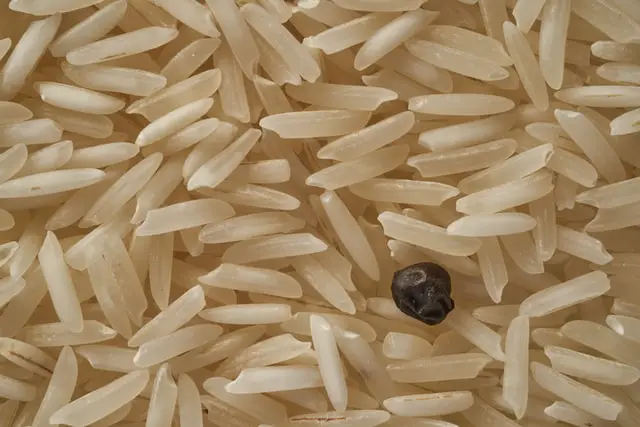
Yes, dogs can eat the Calrose rice variety. Calrose is medium-sized rice with a mild, pleasant taste, soft texture, and moderately sticky consistency.
Calrose rice is low in fats and suitable for dogs needing cholesterol-free diets. However, it is also low in proteins and must always be combined with rich protein sources. In addition, unlike most rice types, the Calrose variety is relatively poor in dietary fiber and not ideal for bland diets for dogs with tummy issues.
The Calrose rice is packed with carbohydrates – sugars, and starches. For dogs requiring an additional energy source, this feature can be considered a pro, while for dogs on weight-loss regimes, it is considered a con.
PART 3 – RICE AND DOGS: FEEDING GUIDELINES
If we try placing rice on the canine food pyramid, we will see that it can be regarded as the main carbohydrate source or treat.
When used as the main carbohydrate source, such as, for example, in bland diets, it can be used more frequently, even daily. However, You must carefully monitor this implementation.
If you plan to use rice regularly, you need to discuss with your vet or canine nutritionist – you do not want to overfeed your dog on rice while depriving it of other vital nutrients.
If you use rice as a treat, you need to respect the 10% treat rule of canine nutrition. Namely, treats should not account for more than 10% of the dog’s daily caloric intake.
Another consideration is the preparation method. When preparing rice for your dog, you need to forget about salt, spices, seasonings, and oils. Dogs can only eat well-cooked (boiled) and plain rice. Adding the mentioned taste enhancers and salts can wreak havoc on the dog’s sensitive digestive system.
Finally, if possible, it is always a better option to purchase organically grown rice and processed rice. That way, you are ensuring high-quality food for your dog.
CONCLUSION
When properly prepared (cooked and plain) and served rationally (moderate amount and frequency), rice makes an excellent addition to the dog’s menu. The wide array of health perks and pleasant taste are added benefits.
However, considering there are many different types of rice, and each has its unique nutritional profile, you will probably have to do some reading before finding the right kind of rice for your dog’s needs.
If you are not sure whether your dog would benefit from rice or if your dog has specific nutritional requirements, do not hesitate to talk to your trusted veterinarian or a licensed canine nutritionist.

